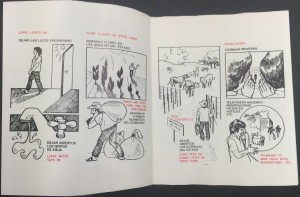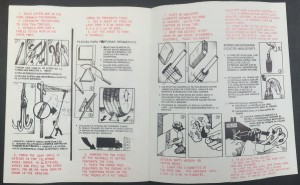Michael Piersall is a senior undergraduate student in Political Science and Human Rights minor. In his blog series, he will study materials available in the Dodd Research Center’s collections to explore American Political Leadership with regards to Cold War activities in Latin America.
As a Political Science major, my academic focus often centers on the decision making process behind government action. As an “American-ist” more specifically, my interest lies in the deliberation and processes of the federal institutions that comprise the United States government. This semester, I have been given the privilege to examine materials in the Thomas J. Dodd Research Center that relate to U.S. governmental actions precipitated by its political hegemony, specifically in Latin America. While these materials are in no way restricted from public access, I deem this a privilege because I am, above all else, a current-affairs wonk; I prefer analyzing events through their perception in contemporary contexts than an isometric historical glance that one can find on, for instance, Wikipedia. Further, my academic orientation towards Human Rights, specifically political and economic rights has provided a lens for additional analysis of the international consequences of U.S. actions.
To that end, I have spent the last few weeks reviewing several documents from the Human Rights Collections that pertain to the U.S. covert operations of the late-1970’s and 1980’s in El Salvador. This assertion of U.S. hegemony is an example of its late 20th Century brand of foreign intervention. Beginning under President Carter, and dramatically expanded under Reagan, this incursion into the domestic affairs took the form of economic, political, and covert wars. Robert Armstrong and Phillip Wheaton, left-leaning journalists for Solidarity Publications, define the two political camps advocating for intervention in El Salvador as either the “Militarists”, bureaucrats in the Department of Defense, the Central Intelligence Agency and other such institutions, and the “Reformists” in offices such as Agency for International Development or the quasi-public American Institute for Free Labor Development, which was created in concert with the AFL-CIO and the funding of the U.S. federal government.
Armstrong and Wheaton, in the aptly named pamphlet Reform and Repression: US Policy in El Salvador (1982) outline the various reasons for which the Reagan administration sought intervention. The common objective of U.S. operations was the total defeat of the coalition of revolutionary guerilla groups known as the Farabundo Martí National Liberation Front (FMLN-FDR) primarily due to the group’s left leaning ideology and the context of Cold War realism. The U.S. military and paramilitary forces, predominantly the CIA, employed the militaristic means towards this end. This largely took the form of military armament sales in opposition to the FMLN-FDR, which can be found inventoried in a pamphlet entitled Invasion: A Guide to the U.S. Military Presence in Central America (1985) published, appropriately enough, by National Action Research on the Military Industrial Complex, seen below:
Invasion details both the sale of small armaments as well as more advanced military hardware, such as helicopters and armored vehicles. The scope and sale of these arms sales and aid packages, not limited to only El Salvador but across all of Central and South America, illustrates the full extent of the operations. Within the context of the post-Carter recession of the early 1980s, the sizable sum indicates the political will within Washington to reestablish U.S. hegemony in the Western hemisphere, particularly given the leftist ideology espoused by the FMLN-FDR. More interestingly, and admittedly more amusing, is the nonmaterial aid provided to combat the FMLN-FDR. This took the form of military and paramilitary training of forces in interrogation and general military tactics. This was not extended only to soldiers, but also to dissidents. The most fascinating document that I came across was a handy reference guide to marginal insurrection, entitled The Freedom Fighters Manuel. This was a training manual for how citizens can aid the overthrow of their governments. This guide outlines (and has conveniently been translated for the reader) the various methods one can use, from the harmless and juvenile:
To the more destructive:
But what this shows is the no-holds barred manner in which these operations were directed, and the importance of El Salvadorian policy in Washington. The reasoning behind these operations was contemporarily judged by Armstrong and Wheaton to be enacting the election promises of the Reagan administration, namely to reassert American supremacy in global affairs, the substantial allocation of resources causes one to surmise the importance of the struggle in America’s own “back yard”. The CIA training manual is a prime example of the increasingly desperate measures that were advocated by the U.S. Government in pursuit of this end. Overall, these documents show the extent to which the policy was pursued by American political leadership, with little regard for the impact it would have on El Salvadorians.
–Michael Piersall
Related Sources:
Gettleman, Marvin E. El Salvador: Central America in the New Cold War. New York: Grove, 1981.
Livingstone, Grace. America’s Backyard : The United States and Latin America from the Monroe Doctrine to the War on Terror. London: Zed, 2009.
McMahan, Jeff. Reagan and the World: Imperial Policy in the New Cold War. New York: Monthly Review, 1985.
Mor, Jessica Stites. Human Rights and Transnational Solidarity in Cold War Latin America. Madison, WI: University of Wisconsin, 2013.



